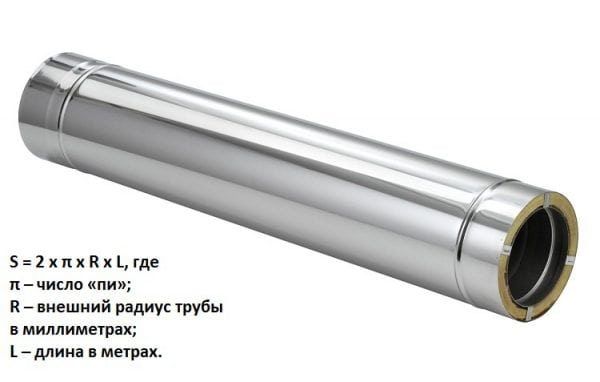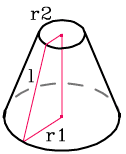In everyday life, construction calculations are usually far from the first place. This also applies to the pipe painting process. Few people calculate in advance how much paint will have to be bought for this work. And this is wrong, because preliminary calculations will save a lot of money. In this regard, the question arises: how to calculate the amount of paints and varnishes necessary for painting various pipes?
- Where to begin
- How it's done
- Cylindrical
- Cylindrical sewer
- Profile
- Cone shaped
- Corrugated
- Pipe Area Calculator
- What and how to paint?

Where to begin
The paint consumption depends not only on the size of the pipe, but also on the material used for its manufacture, and on the shape.
Most often you can find pipes in the form of a cylinder. But there are other types:
- In the shape of a rectangle. Outwardly they look like an ordinary bar. They are called profile in another way.
- Cone-shaped. The name speaks for itself. Used very rarely. The scope of their application is pressure injection systems.
- Corrugated.
- For sewage equipment. They are large cement rings.
The dimensions of each type of pipe comply with the requirements stated for them in special documents.
to contents ↑How it's done
Several geometric formulas will help you calculate paint consumption. They will differ depending on the type of pipe.
Cylindrical
The area of a cylindrical product is calculated by the following formula: S = 2 * π * R * L. The values indicated in it:
- π is the number "pi";
- R is the outer radius of the pipe in millimeters;
- L is the length in meters.
For example, if the pipe is 10 m long and its diameter is 60 mm, the surface area will be 1.88 m2. Calculations for frequently used pipe diameters can be found in the corresponding tables or use our a calculator.
Knowing the surface area for painting and the properties of a particular paint, you can easily determine its consumption.
to contents ↑Cylindrical sewer
The area of such products is calculated according to the above formula. The only difference is the large size. The calculation is based on a height of 90 cm. It is these rings that are used to equip sewers most often. The outer diameter can vary from 70 to 200 cm. Here are a few examples:
- With a diameter of 70 cm, the area will be 1.99 m2.
- If the diameter is one meter, the area will be 2.83 m2.
- For the largest products (diameter - two meters), the surface area for painting will be 5.65 m2.
Profile
To determine the area of a profile pipe necessary for painting, you need to know its dimensions:
- H is the height of one side;
- W is the height of the other side;
- L is the length.
For calculations, the following formula is used: S = 2 * H * L + 2 * W * L. If the length of the product is still the same 10 meters and its sides are 5 and 10 cm, the total area will be three square meters.
to contents ↑Cone shaped
Most of these structures are a truncated cone. The area of its lateral surface can be calculated by the following formula: S = π *(R11+ R2) * L. It consists of such quantities:
- R1 is the radius of the smaller circle;
- R2 is the radius of the larger circle;
- L is the generatrix of the truncated cone: the length of the wall from the narrow to the widest part of the pipe.
to contents ↑With the dimensions of the structure ten meters, three and six centimeters in diameter, the staining area will be almost one and a half square meters.
Corrugated
It is most difficult to calculate the color of the corrugated pipe. All the values obtained during the work, experts recommend entering in the table.
So, for starters, you need to decide on these sizes:
- rounding radius - A;
- projections of straight sections on the length and diameter (B and D);
- corrugated part pitch - C;
- bevel angle of the flat part - E;
- corrugated section height - F;
- the line along which the product can stretch is G.
In fact, a corrugated pipe is the same cylinder that can be extended along line G.
The calculations look something like this.
- Assume that A is 3 mm. The rounded part is calculated using the formula 2 x π x A. In this case, it will be 18.84 mm.
- The value of D must be doubled. Let it be equal to 20 mm.
- If we take into account the above data, we can determine that the corrugation in the stretched form will be equal to 38.84 mm.
- If you remove the bevel angle, you can calculate the value of E. It is equal to twice the diameter, or 12 mm.
- As in previous cases, the length of the product is 10 m. Knowing this, you can calculate the number of folds. To do this, the length must be divided by a step. It turns out 866 pcs.
- Knowing all these sizes, you can calculate the length of the product in a stretched form. To do this, 866 must be multiplied by 38.84 mm. It turns out that the length of the stretched corrugation will be 33.64 m.
- If the diameter of the corrugation in the stretched form is, for example, 52 mm, the area for painting will be 54.92 m2.
Pipe Area Calculator
to contents ↑What and how to paint?
After the area of the surface to be painted and the consumption of material have been calculated, the coloring composition can be selected. The following types of paints are used for painting pipes:
- Acrylic based enamel. It contains organic solvents. A durable shiny coating is formed on the surface.
- Alkyd enamel. It features a large assortment of colors. Allows you to create a durable coating that does not crack or wear.
- Water dispersion formulations. Dry faster than other coloring matter. In addition, they do not have an unpleasant odor. Before using such substances, a primer must be applied to the pipe surface.
- Oil paint. For such purposes it is used extremely rarely.
The first coat must be applied primer. It will protect the surface from rust and increase the strength of the connection with the paint. After the primer dries, apply two coats of the paint composition.
Calculating paint consumption manually is not so easy - for this you will have to recall a few geometric formulas. Before starting the calculations, it is necessary to make measurements of the structure. To facilitate the process, you can use ready-made tables or a pipe surface area calculator.










